 W
WAħrax Tower, originally known as Torre di Lacras, and also known as Armier Tower, Ta' Ħoslien Tower or the White Tower, is a small watchtower overlooking Armier Bay in the limits of Mellieħa, Malta. It was built in 1658 as the sixth of the De Redin towers. An artillery battery was built around it in 1715. Today, the tower and battery are intact. After receiving 3 years of restoration work the tower was reopened to the public on the 9th of June 2021.
 W
WArrias Battery, also known as Xemxija Battery or Pwales Left Battery, is an artillery battery in Xemxija, limits of St. Paul's Bay, Malta. It was built by the Order of Saint John in 1715–1716 as one of a series of coastal fortifications around the Maltese Islands. The battery still exists, although it has modern alterations, and it is used as a restaurant.
 W
WBuġibba Battery, also known as Elbene Battery, was an artillery battery in Buġibba, limits of St. Paul's Bay, Malta. It was built in the 18th century, by the Order of Saint John, as one of a series of coastal fortifications around the coasts of the Maltese Islands. The battery no longer exists, but its rock-hewn ditch and some foundations can still be seen.
 W
WCambridge Battery is a Victorian-era battery in Sliema, Malta. It is commonly referred to as Fort Cambridge, although it was never classified as a fort while in use. It originally contained an Armstrong 100-ton gun.
 W
WCapuchin Convent Battery, also known as Kalkara Battery, was an artillery battery in Kalkara, Malta, built by Maltese insurgents during the French blockade of 1798-1800. It was part of a chain of batteries, redoubts and entrenchments encircling the French positions in Marsamxett and the Grand Harbour.
 W
WThe Corradino Batteries were a series of artillery batteries on Corradino Heights, near Paola, Malta, that were built by Maltese insurgents during the French blockade of 1798-1800. The batteries formed part of a chain of batteries, redoubts and entrenchments encircling the French positions in Marsamxett and the Grand Harbour.
 W
WFort St. Angelo is a bastioned fort in Birgu, Malta, located at the centre of the Grand Harbour. It was originally built in the medieval period as a castle called the Castrum Maris. It was rebuilt by the Order of Saint John as a bastioned fort called Fort Saint Angelo between the 1530s and the 1560s, and it is best known for its role as the Order's headquarters during the Great Siege of Malta of 1565. A major reconstruction to designs of Carlos de Grunenbergh took place in the 1690s, giving the fort its current appearance.
 W
WDelimara Tower, originally known as Torre della Limara, was a small watchtower in Delimara, limits of Marsaxlokk, Malta. It was built in 1659 as the tenth of the De Redin towers, and an artillery battery was later built nearby in 1793. Both the tower and the battery have been demolished.
 W
WDella Grazie Battery, also known as Xgħajra Battery, is an artillery battery in Xgħajra, Malta. It was built by the British between 1888 and 1893. The battery stands above the shore to the east of Grand Harbour, between Fort Saint Rocco and Fort Saint Leonardo. It is currently in a dilapidated state, and part of the battery is used as the town hall for Xgħajra.
 W
WDellia Battery, also known as Vendôme Battery or Pwales Right Battery, was an artillery battery in Xemxija Bay, limits of St. Paul's Bay, Malta. It was built by the Order of Saint John in 1715 as one of a series of coastal fortifications around the coasts of the Maltese Islands. It was demolished in 1924, but the coats of arms and inscription which were located above the main entrance still exist and are now a monument.
 W
WFerretti Battery, also known as Qajjenza Battery or Saint George's Battery, is an artillery battery in the village of Qajjenza, within the limits of Birżebbuġa, in Malta. It was built by the Order of Saint John between 1715 and 1716 as one of a series of coastal fortifications around the coasts of the Maltese Islands. A restaurant exists within the walls of the battery, serving Mediterranean cuisine.
 W
WFort Binġemma is a polygonal fort in the limits of Rabat, Malta. It was built between 1875 and 1878 by the British as part of the Victoria Lines. The fort has been illegally occupied by the Buttigieg family since 2009, who occasionally use it as a restaurant. It is set on a hill of around 590 feet above sea level. Previous to the building of the fort there used to be a Roman city or village.
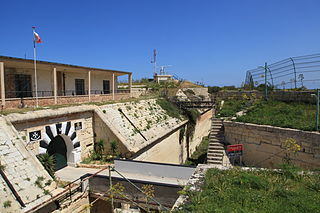 W
WFort Madalena, also known as Fort Madliena, is a polygonal fort in Madliena, limits of Swieqi, Malta. It was built between 1878 and 1880 by the British as part of the Victoria Lines. The fort now falls under the responsibility of the Armed Forces of Malta and is used by the St John Rescue Corps.
 W
WFort Mosta is a polygonal fort in Mosta, Malta. It was built between 1878 and the 1880s by the British as part of the Victoria Lines. It is still in use today by the Armed Forces of Malta as an ammunition depot.
 W
WGarden Battery is an artillery battery in Sliema, Malta. It was built by the British between 1889 and 1894. The battery is located at Tigné Point, between Cambridge Battery and Fort Tigné.
 W
WGħargħar Battery, also known as Ta' Ittuila Battery and Ta' Xindi Battery, was an artillery battery in present-day San Ġwann, Malta, built by Maltese insurgents during the French blockade of 1798–1800. It was part of a chain of batteries, redoubts and entrenchments encircling the French positions in Marsamxett and the Grand Harbour.
 W
WJesuit Hill Battery, also known as Jesuit Battery or Point Cortin Battery, was an artillery battery in Marsa, Malta, built by Maltese insurgents during the French blockade of 1798–1800. It was part of a chain of batteries, redoubts and entrenchments encircling the French Military's position in Marsamxett and the Grand Harbour.
 W
WLascaris Battery, also known as Fort Lascaris or Lascaris Bastion, is an artillery battery located on the east side of Valletta, Malta. The battery was built by the British in 1854, and it is connected to the earlier St. Peter & Paul Bastion of the Valletta Land Front. In World War II, the Lascaris War Rooms were dug close to the battery, and they served as Britain's secret headquarters for the defence of the island.
 W
WLembi Battery, also known as Qala Lembi Battery, was an artillery battery in Sliema, Malta. It was built in 1757 by the Order of Saint John, and was considered as an outwork of Fort Manoel. The battery became obsolete with the construction of Fort Tigné in 1795, and it was briefly used as a summer residence before being demolished. In the 1870s, Cambridge Battery was built close to the site of Lembi Battery.
 W
WThe Cittadella, also known as the Castello, is the citadel of Victoria on the island of Gozo, Malta. The area has been inhabited since the Bronze Age, and the site now occupied by the Cittadella is believed to have been the acropolis of the Punic-Roman city of Gaulos or Glauconis Civitas.
 W
WMadliena Tower, originally known as Torre della Paulina, is a small watchtower in Madliena, limits of Pembroke, Malta. It was completed in 1658 as the fourth of the De Redin towers. The British built an artillery battery next to the tower in 1908–1909, and the tower and battery remained in use until World War II. Today, the battery no longer exists but the tower is in good condition.
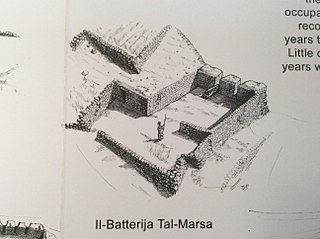 W
WMarsa Battery was an artillery battery in Marsa, Malta, built by Maltese insurgents during the French blockade of 1798-1800. It was part of a chain of batteries, redoubts and entrenchments encircling the French positions in Marsamxett and the Grand Harbour.
 W
WMistra Battery, formerly also known as Despirasse Battery, is an artillery battery in Mistra Bay, Mellieħa, Malta. It was built by the Order of Saint John in the 18th century as one of a series of coastal fortifications around the coasts of the Maltese Islands.
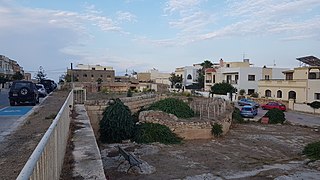 W
WPembroke Battery was an artillery battery in Pembroke, Malta, Malta. It was built by the British between 1897 and 1899, and most of it was demolished in the 1980s.
 W
WPinto Battery, also known as Għżira Battery or Kechakara Battery, is a former artillery battery in Birżebbuġa, Malta. It was built by the Order of Saint John between 1715 and 1716 as one of a series of coastal fortifications around the coasts of the Maltese Islands. The battery has been heavily altered over time, and the blockhouse now houses a bar and a garage, while the gun platform and parapet have been largely destroyed, with only the general outline still visible.
 W
WFort Ricasoli is a bastioned fort in Kalkara, Malta, which was built by the Order of Saint John between 1670 and 1698. The fort occupies a promontory known as Gallows' Point and the north shore of Rinella Bay, commanding the entrance to the Grand Harbour along with Fort Saint Elmo. It is not only the largest fort in Malta but also the largest in Europe, and it has been on the tentative list of UNESCO World Heritage Sites since 1998, as part of the Knights' Fortifications around the Harbours of Malta.
 W
WQalet Marku Battery, also known as D'Orbeau Battery, was an artillery battery in Baħar iċ-Ċagħaq, limits of Naxxar, Malta. It was built in 1715–1716 by the Order of Saint John as one of a series of coastal fortifications around the Maltese Islands. The battery has been largely destroyed, but some remains can still be seen.
 W
WQawra Tower, also known as Qawra Point Tower or Fra Ben Tower, is a small watchtower in Qawra, limits of St. Paul's Bay, Malta. It was completed in 1638 as the fourth of the Lascaris towers. An artillery battery was built around the tower in 1715. Today, the tower and battery are a restaurant.
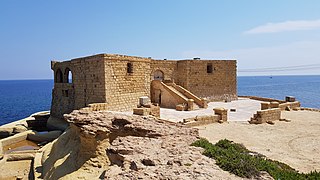 W
WQolla l-Bajda Battery is an artillery battery in Żebbuġ, Gozo, Malta. It was built by the Order of Saint John between 1715 and 1716 as one of a series of coastal fortifications around the coasts of the Maltese Islands. It retained its original layout until the late 1970s, when it was converted into a discothèque and snack bar known as Rook and major alterations were made to the battery. The building is now abandoned and in a dilapidated state, being in the midst of a legal battle between the government and a private company.
 W
WRamla Left Battery, also known as Belancourt Battery or Xagħra Battery, was an artillery battery in Ramla Bay, limits of Xagħra on the island of Gozo, Malta. It was built by the Order of Saint John in 1715–1716 as one of a series of coastal fortifications around the Maltese Islands. The battery now lies in ruins.
 W
WRamla Right Battery, also known as Gironda Battery or Nadur Battery, was an artillery battery in Ramla Bay, limits of Nadur on the island of Gozo, Malta. It was built by the Order of Saint John in 1715–1716 as one of a series of coastal fortifications around the Maltese Islands. The battery now lies in ruins.
 W
WRiħama Battery is an artillery battery in Marsaskala, Malta. It was built by the Order of Saint John in 1714–1716 as one of a series of coastal fortifications around the coasts of the Maltese Islands. The battery still exists, although it is in a dilapidated state with part of it having collapsed.
 W
WRinella Battery is a Victorian battery in Kalkara, Malta. It is commonly referred to as Fort Rinella, although it was never classified as a fort while in use. It contains one of two surviving Armstrong 100-ton guns.
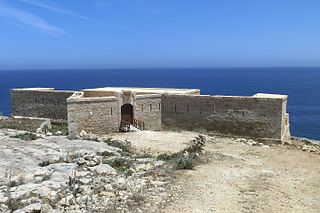 W
WSaint Anthony's Battery is an artillery battery in Qala, Gozo, Malta. It was built by the Order of Saint John between 1731 and 1732 as one of a series of coastal fortifications around the coasts of the Maltese Islands. It is one of only two surviving batteries on Gozo, the other one being Qolla l-Bajda Battery in Żebbuġ.
 W
WSaint Julian's Tower, originally known as Torre di San Giuliano and also known as Sliema Tower, is a small watchtower in Sliema, Malta. It was completed in 1658 as the fifth of the De Redin towers. An artillery battery was built around the tower in 1715. Today, the tower and the remains of the battery are a restaurant.
 W
WFort San Lucian, also known as Saint Lucian Tower or Fort Rohan, is a large bastioned watchtower and polygonal fort in Marsaxlokk, Malta. The original tower was built by the Order of Saint John between 1610 and 1611, being the second of six Wignacourt towers.
 W
WSaint Mary's Battery, also known as Comino Battery, is an artillery battery on the island of Comino in Malta. It was built by the Order of Saint John between 1715 and 1716 as one of a series of coastal fortifications around the coasts of the Maltese Islands.
 W
WSaint Paul's Battery, also known as Ta' Lombardi Battery, is an artillery battery in Marsaxlokk, Malta. It stands on high ground at the shoreward end of Delimara Point, above il-Ħofra-z-Zgħira. It is a polygonal fort and was built by the British from 1881 to 1886. It commands a field of fire northwards over St Thomas' Bay and Marsaskala.
 W
WSaint Peter's Battery was an artillery battery in Kalkara, Malta, built by Maltese insurgents during the French blockade of 1798–1800. It was part of a chain of batteries, redoubts and entrenchments encircling the French positions in Marsamxett and the Grand Harbour.
 W
WSaint Thomas Tower, also known as Fort Saint Thomas, is a large bastioned watchtower in Marsaskala, Malta. It was built in 1614, the third of six Wignacourt towers. An artillery battery was added to the tower in the early 18th century. Saint Thomas Tower is the largest watchtower in Malta.
 W
WThe Saluting Battery is an artillery battery in Valletta, Malta. It was constructed in the 16th century by the Order of Saint John, on or near the site of an Ottoman battery from the Great Siege of Malta. The battery forms the lower tier of St. Peter & Paul Bastion of the Valletta Land Front, located below the Upper Barrakka Gardens and overlooking Fort St. Angelo and the rest of the Grand Harbour.
 W
WFort Ricasoli is a bastioned fort in Kalkara, Malta, which was built by the Order of Saint John between 1670 and 1698. The fort occupies a promontory known as Gallows' Point and the north shore of Rinella Bay, commanding the entrance to the Grand Harbour along with Fort Saint Elmo. It is not only the largest fort in Malta but also the largest in Europe, and it has been on the tentative list of UNESCO World Heritage Sites since 1998, as part of the Knights' Fortifications around the Harbours of Malta.
 W
WSan Rocco Battery was an artillery battery in Kalkara, Malta, built by Maltese insurgents during the French blockade of 1798–1800. It was the last in a chain of batteries, redoubts and entrenchments encircling the French positions in Marsamxett and the Grand Harbour. It was built to control the entrance to the harbour as well as the French occupied Fort Ricasoli. The battery was continually being fired upon from the French at Ricasoli.
 W
WSliema Point Battery, also known as Fort Sliema, is an artillery battery in Sliema, Malta. It was built by the British between 1872 and 1876. The battery stands on the peninsula that separates Marsamxett Harbour from St. Julian's Bay. The battery was later used as a searchlight position, and it is now a restaurant known as Il-Fortizza.
 W
WTa' Għemmuna Battery was an artillery battery in St. Julian's, Malta, that was built by Maltese insurgents during the French blockade of 1798–1800. The battery was located at Dragonara Point, in front of the Hospitaller entrenchments at Spinola. The battery had a large parapet with nine embrasures and a magazine. It was armed with seven guns, which had been taken from St. Mary's Tower and St. Paul's Bay.
 W
WTal-Borg Battery was an artillery battery near Tarxien, Malta, built by Maltese insurgents during the French blockade of 1798–1800. It was part of a chain of batteries, redoubts and entrenchments encircling the French positions in Marsamxett and the Grand Harbour.
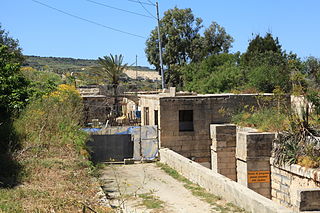 W
WTarġa Battery is an artillery battery on the boundary between St. Paul's Bay and Mosta, Malta. It was built in 1887 by the British as part of the Victoria Lines. The battery is now in the hands of the Mosta Local Council, who intend to restore it and open it to the public.
 W
WTas-Samra Battery was an artillery battery in Ħamrun, Malta, built by Maltese insurgents during the French blockade of 1798–1800. It was part of a chain of batteries, redoubts and entrenchments encircling the French positions in Marsamxett and the Grand Harbour.
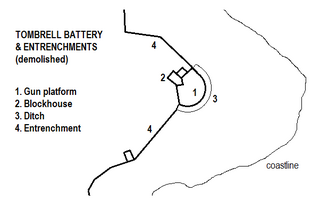 W
WTombrell Battery was an artillery battery in Delimara, Marsaxlokk, Malta. It was built in around 1722 by the Order of Saint John as one of a series of coastal fortifications around the coasts of the Maltese Islands. The battery was demolished at the end of the 19th century, and only its rock-hewn ditch survives today.
 W
WVendôme Battery, also known as Ta' Maċċu Battery, is an artillery battery near Armier Bay, limits of Mellieħa, Malta. It was built by the Order of Saint John in 1715–1716 as one of a series of coastal fortifications around the Maltese Islands.
 W
WWardija Battery was an artillery battery in Wardija, a hilltop in the limits of St. Paul's Bay, on the northern coast of Malta. It was built by the British in 1915, and saw use during World War I. It became obsolete following the construction of Fort Campbell in 1938.
 W
WWestreme Battery, also known as ir-Rasus Battery or Mellieħa Right Battery, is a former artillery battery in Mellieħa, Malta. It was built by the Order of Saint John in 1715–1716 as one of a series of coastal fortifications around the coasts of the Maltese Islands.
 W
WWied Musa Battery, also known as Swatar Battery, is a former artillery battery in Marfa, limits of Mellieħa, Malta. It was built by the Order of Saint John in 1714–1716 as one of a series of coastal fortifications around the Maltese Islands.
 W
WWignacourt Tower, also known as Saint Paul's Bay Tower, is a bastioned watchtower in St. Paul's Bay, Malta. It was the first of six Wignacourt towers to be built, and it was completed in 1610. It replaced the role of Ta' Tabibu farmhouse which was previously known as Dejma Tower. An artillery battery was added a century later in 1715. Today the tower is a museum.
 W
WWilġa Battery, also known as Saint James Battery or Zondodari Battery, is a former artillery battery in Delimara, Marsaxlokk, Malta. It was built in 1714 by the Order of Saint John as one of a series of coastal fortifications around the coasts of the Maltese Islands. Today, the battery's gun platform is largely destroyed, but its blockhouse remains intact and has been restored.
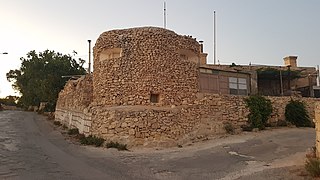 W
WWolseley Battery is an artillery battery in Delimara, Marsaxlokk, Malta. It was built by the British between 1897 and 1899, and is located close to Fort Tas-Silġ. Today, the battery still exists, but it is not accessible to the public.
 W
WThe Żabbar Batteries and Redoubt were a series of artillery batteries and a redoubt in Żabbar, Malta, built by Maltese insurgents during the French blockade of 1798–1800. They formed part of a chain of batteries, redoubts and entrenchments encircling the French positions in Marsamxett and the Grand Harbour.
 W
WThe Żejtun Batteries were a series of artillery batteries in Żejtun, Malta, built by Maltese insurgents during the French blockade of 1798–1800. They were part of a chain of batteries, redoubts and entrenchments encircling the French positions in Marsamxett and the Grand Harbour.
 W
WŻonqor Battery is an artillery battery in Marsaskala, Malta, standing on high ground overlooking Marsaskala Bay. It is a polygonal fort and was built by the British from 1882 to 1886.